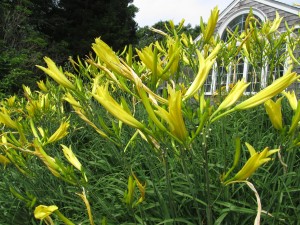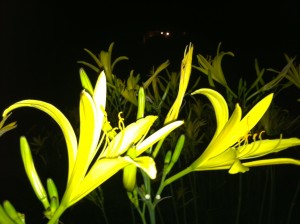A typical daylily flower opens early in the morning and fades in late afternoon. There is a class of night-blooming (nocturnal) daylilies recognized by the American Hemerocallus Society (AHS). Flowers of nocturnal daylilies open anytime from late afternoon to dusk, bloom through the night, and close-up (wither) starting in mid-morning.
Introducing the true nocturnals…they open around dusk and remain in flower through the night. Probably, the best known of a nocturnal daylily is fragrant lemon-yellow ‘Citrina’, an introduction from China over a century ago. Recent additions to the nocturnal class include: ‘Alna Pride’ (7-inch peachy-yellow, red halo center), ‘Ethel Shepherd’ (6-inch gold peach, ruffled edge), ‘Lady Grosvenor’ (6-inch pale pink, yellow throat flower), ‘Quick Gold’ (6-inch butter gold), ‘Spread Gold’ (7-inch bright yellow, green-yellow center), and ‘Tall Angel’ (6-inch pink, green throat).
AHS also lists an “Extended Daylilies” grouping within the Nocturnal class. Extended Daylilies bear flowers which remain open for 16 or more hours a day. The flowers of many extended daylilies open in mid- to late morning and close in late evening, often after dark.
The popular golden yellow cultivar ‘Stella d’Oro’ belongs in the Extended Daylilies class. Blooms stay open 16 or more hours a day and hold up well into the evening hours. Others in the Extended Daylilies class include ‘Happy Returns’, ‘Pardon Me’, ‘Bitsy’, and ‘Buttered Popcorn’. They are short-growing (18 to 24 inch high) cultivars and re-bloom in late summer or early fall.
To get the most out of nocturnal daylilies, select for light and bright colors and high scent. Light yellow to orange colored blooms are more visible in the evening garden, particularly on moonlit nights. Adding landscape lighting also helps. Lastly, enjoy the delightful fragrance of some cultivars.
Nocturnal daylilies are rarely available at local garden centers. It is best to search e-commerce nursery sources over the internet. Tranquil Lake Nursery in Rehoboth, MA is a good shopping source. Many extended cultivars are easily found at local nurseries.



 Posted in
Posted in 
